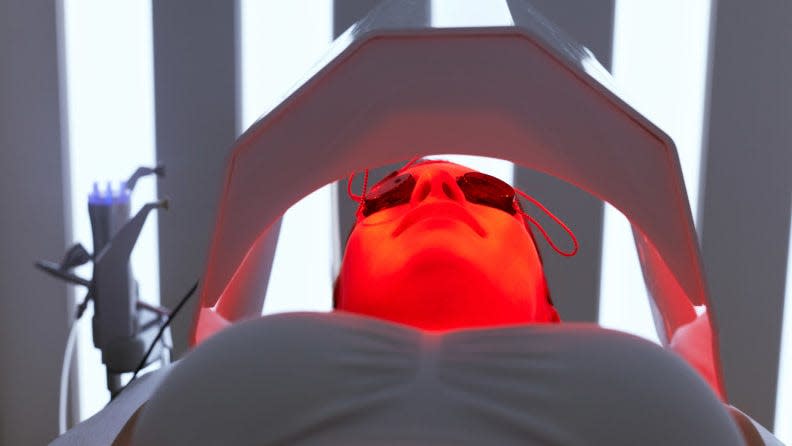TikTokers are zapping their skin with red light; dermatologists say they’re on to something
Is the secret to glowing, youthful skin zapping your face with red light?
Quite a few TikTokers think so, with videos tagged #redlighttherapy garnering more than 96 million views on the app. In the videos, users expose their skin to red light to treat a wide range of cosmetic conditions, including acne, signs of aging and hair loss.
Turns out, the TikTokers may be on to something − and red light has been on dermatologists' radars for a while.
"Red light is something dermatologists have been using for quite some time now," says Dr. Anthony Rossi, a New York-based dermatologist. "I'm a big proponent of red light therapy, because I use it in a clinical setting."

What is red light therapy?
Skin care enthusiasts might reflexively recoil at the idea of intentionally exposing their skin to a form of radiation. After all, ultraviolent rays from the sun cause a host of problems, including accelerating signs of aging and, at worst, skin cancer.
But red light − a spectrum of visible light around 600 nanometers in wavelength − shows promise as a safe way of healing the skin of many problems, says Dr. Danilo Del Campo, a Chicago-based dermatologist, adding that scientists began researching the effects of red light on the body in the 1960s and found it helpful in healing wounds.
That's because red light, he says, stimulates the production of adenosine triphosphate, or ATP, an energy compound he describes as "the gasoline of our body."
By boosting ATP, red light therapy can heal wounds and stimulate hair growth, he says. Though the largest and most robust studies have shown red light therapy's effectiveness in these two areas, Dr. Del Campo adds smaller studies have shown potential for red light in regulating the skin's oil production, thereby reducing acne, as well as boosting the skin's collagen production, which can reduce signs of aging.
"It's still an exciting field that hasn't been explored in large trials yet," he says.
Many people deal with pimples. What causes acne?
What do doctors say about red light therapy?
Still, dermatologists say clinical evidence indicates red light therapy is safe to try, and it's offered at many dermatologists offices. Here's what to know if you're interested:
Consult your dermatologist first: It's important to first meet with a board-certified dermatologist and let them know you're interested in red light therapy. Most dermatologists can administer the treatment in their offices, which Rossi recommends over at-home devices. "Seeing a board-certified dermatologist who does red light therapy ... is probably your best bet, because the tools that they're using are medical grade, they're standardized, they know how to use them, they know how to properly place them," he says.
Not all at-home red light therapy devices are created equal: If you do seek out an at-home red light therapy device, such as a mask, Del Campo advises purchasing one from a reputable company or one that your dermatologist recommends. He also says you should follow all directions that come with the device or that are given to you by your dermatologist, especially when it comes to frequency and duration of exposure, to avoid burning your skin.
Protect your eyes: Keep in mind that what's good for your skin may not be good for your eyes. "I do like to tell my patients that if they're going to use a red light panel at home, they should wear proper eye protection," Rossi says. "They shouldn't look directly at the light, because you don't want to cause any eye issues."
Don't throw out the rest of your skin care routine: Remember, red light therapy is a supportive, not primary therapy, so don't use it in place of your skin care regimen, medication or regular sunscreen application, Del Campo says.
Most of all, remember red light therapy is something that can enhance your skin care, but it's not a necessity for healthy skin − and it's certainly no magic cure for every condition.
"There are things that you think you may be treating with red light that you probably would better be better off treating with topical prescriptions," Rossi says. "Red light alone may not cure it, whereas using red light in conjunction with prescription-strength medicines is really helpful."
Does 'skin cycling' actually work? I tried it for one month.
This article originally appeared on USA TODAY: Red light therapy: Does it work for acnes, hair loss and more?

